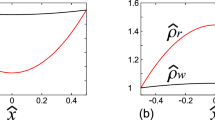Abstract
A study is made of blood flow by assuming that the blood constitutes a suspension of cells in plasma instead of a simple homogeneous fluid. A macroscopic theory governing the motion of plasma in a plasma-cell system is derived from the local volume averaging method for a system without mass transfer between the phases, and its characteristic length is much larger than the size of the cells. The equations governing the motion of the local averaged fluid quantities include one additional term in the equation of motion and two additional terms in the energy equation. These terms represent, respectively, the force exerted upon the fluid by the particles, and the rate of heat transfer and work done upon the fluid by the particles. The theory is applied to obtain the effective viscosity as the explicit function of the volume concentration of the cells by assuming that the cells behave like rigid spherical particles with slip-collision, and the plasma is an incompressible Newtonian fluid. Comparison with existing experimental results shows a good agreement. The theory is also used to obtain the effects of cell distribution upon the overall effective viscosity in a circular tube. The quantitative result shows that there is a decrease in overall effective viscosity as the concentration of cells increases toward the center of the tube, and the overall effective viscosity is smaller than the flow with evenly distributed cells.
Similar content being viewed by others
Literature
Bayliss, L. E. 1960.Flow Properties of Blood (Ed. Copley and Stainsby). Pergamon Press.
Bugliarello, G. and J. Sevilla. 1970. “Velocity Distribution and Other Characteristics of Steady and Pulsatile Blood Flow in Fine Glass Tubes.”Biorheology 7, 1–23.
— 1969. “Some Aspect of Biomechanics of the Microcirculation, anno. 1969.” Proceedings 11th Midwestern Mechanics Conf.,Development in Mechanics,5, 921–962.
Chow, J. C. F. 1964. “Attentuation of Acoustic Waves in Dilute Emulsions and Suspension.”J. Acous. Soc. Am.,36, 2395–2401.
Chu, B. T. and J. C. F. Chow. 1965. “On a Macroscopic Theory of a Two-Phase Fluid.” AIAA 2nd Aerospace Science Meeting, New York, January 1965, Paper No. 65-8.
Fahraeus, R. and T. Lindquist. 1931. “The Viscosity of Blood in Narrow Tubes.”Am. J. Physiol.,96, 562–568.
Fung, Y. C. 1969. “Blood Flow in the Capillary Bed.”J. Biomechanics,1, 353–372.
Happel, J. 1958. “Viscosity of Suspensions of Uniform Spheres.”J. Appl. Phys.,28, (1), 1288–1292.
Haynes, R. H. 1961. “The Rheology of Blood.”Trans. Soc. Rheology,5, 85–101.
Jeffery, G. B. 1922. “The Motion of Ellipsoidal Particles Immersed in a Viscous Fluid.”Proc. Roy. Soc.,102A, 161–179.
Klug, P. O., L. S. Lessin and P. Radice. 1974. “Rheological Aspect of Sickle Cell Disease.”Arch. Intern. Med.,133, 577–590.
Lih, M. M. 1969. “A Mathematical Model for the Axial Migration of Suspended Particles in Tube Flow.”Bull. Math. Biophys.,31, 143–157.
Manley, R. St. J. and S. G. Mason. 1952. “Particle Motions in Sheared Suspensions, II. Collisions of Uniform Spheres.”J. Collid. Sci.,1, 354–369.
Maude, A. D. 1960. “The Viscosity of a Suspension of Spheres.”J. Fluid Mech.,1, 230–236.
Merrill, E. W., A. M. Benis, E. R. Gilliland, T. K. Sherwood and E. W. Salzman. 1965. “Pressure-Flow Relations of Human Blood in Hollow Fibers at Low Flow Rates.”J. Appl. Physiology,20 (50), 954–967.
Nir, A. and A. Acrivos. 1974. “Experiments on the Effective Viscosity of Concentrated Suspension of Solid Sphere.”Int. J. Multiphase Flow,1, 373–381.
Sacke, A. H. and E. G. Tickner. 1969.Hemorheology (Ed. Copley), 277–303. Pergamon Press.
Soo, S. L. 1967.Fluid Dynamics of Multiphase System. Waltham Mass.: Blaisdell Pub. Co.
Vand, V. 1948. “Viscosity of Solutions and Suspensions.”J. Phys. and Collid. Chem.,52, 300–332.
Ward, S. G. and R. L. Whitmore. 1951. “Studies of the Viscosity and Sedimentation of Suspensions.”Br. J. Appl. Phys.,1, 286–290.
Zien, T. F. 1969. “Hydrodynamics of Bolus Flow: An Analytical Approach to Blood Flow in Capillaries.”Bull. Math. Biophys. 31, 681–694.
Author information
Authors and Affiliations
Rights and permissions
About this article
Cite this article
Chow, J.C.F. Blood flow: Theory, effective viscosity and effects of particle distribution. Bltn Mathcal Biology 37, 471–488 (1975). https://doi.org/10.1007/BF02459515
Received:
Revised:
Issue Date:
DOI: https://doi.org/10.1007/BF02459515




